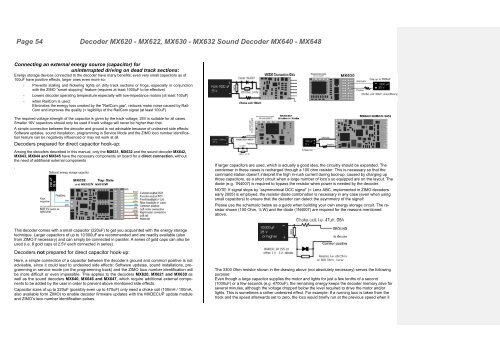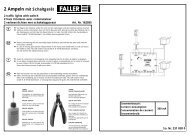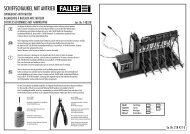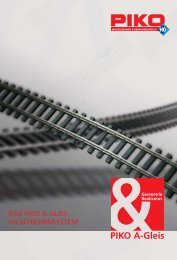INSTRUCTION MANUAL
INSTRUCTION MANUAL
INSTRUCTION MANUAL
You also want an ePaper? Increase the reach of your titles
YUMPU automatically turns print PDFs into web optimized ePapers that Google loves.
Page 54<br />
Decoder MX620 - MX622, MX630 - MX632 Sound Decoder MX640 - MX648<br />
Connecting an external energy source (capacitor) for<br />
uninterrupted driving on dead track sections:<br />
Energy storage devices connected to the decoder have many benefits; even very small capacitors as of<br />
100uF have positive effects, larger ones even more so:<br />
- Prevents stalling and flickering lights on dirty track sections or frogs, especially in conjunction<br />
with the ZIMO “smart stopping” feature (requires at least 1000uF to be effective)<br />
- Lowers decoder operating temperature especially with low-impedance motors (at least 100uF)<br />
- when RailCom is used:<br />
Eliminates the energy loss created by the “RailCom gap”, reduces motor noise caused by Rail-<br />
Com and improves the quality (= legibility) of the RailCom signal (at least 100uF)<br />
The required voltage strength of the capacitor is given by the track voltage; 25V is suitable for all cases.<br />
Smaller 16V capacitors should only be used if track voltage will never be higher than that.<br />
A simple connection between the decoder and ground is not advisable because of undesired side effects:<br />
Software updates, sound installation, programming in Service Mode and the ZIMO loco number identification<br />
feature can be negatively influenced or may not work at all.<br />
Decoders prepared for direct capacitor hook-up:<br />
Among the decoders described in this manual, only the MX631, MX632 and the sound decoder MX642,<br />
MX643, MX644 and MX645 have the necessary components on board for a direct connection, without<br />
the need of additional external components<br />
.<br />
If larger capacitors are used, which is actually a good idea, the circuitry should be expanded. The<br />
condenser in these cases is recharged through a 100 ohm resistor. This is necessary so that the<br />
command station doesn’t interpret the high in-rush current during boot-up, caused by charging up<br />
those capacitors, as a short circuit when a large number of loco’s so equipped are on the layout. The<br />
diode (e.g. 1N4007) is required to bypass the resistor when power is needed by the decoder.<br />
NOTE: If signal stops by “asymmetrical DCC signal” (= Lenz ABC, implemented in ZIMO decoders<br />
early 2005) is employed, the resistor-diode combination is necessary in any case (even when using<br />
small capacitors) to ensure that the decoder can detect the asymmetry of the signal!<br />
Please use the schematic below as a guide when building your own energy storage circuit. The resistor<br />
shown (100 Ohm, ¼ W) and the diode (1N4007) are required for the reasons mentioned<br />
above.<br />
This decoder comes with a small capacitor (220uF) to get you acquainted with the energy storage<br />
technique. Larger capacitors of up to 10’000uF are recommended and are readily available (also<br />
from ZIMO if necessary) and can simply be connected in parallel. A series of gold caps can also be<br />
used (i.e. 8 gold caps at 2.5V each connected in series).<br />
Decoders not prepared for direct capacitor hook-up:<br />
Here, a simple connection of a capacitor between the decoder’s ground and common positive is not<br />
advisable, since it could lead to undesired side effects: Software updates, sound installations, programming<br />
in service mode (on the programming track) and the ZIMO loco number identification will<br />
be more difficult or even impossible. This applies to the decoders MX620, MX621 and MX630 as<br />
well as the sound decoders MX640, MX646 and MX647, which require additional external components<br />
to be added by the user in order to prevent above mentioned side effects.<br />
Capacitor sizes of up to 220uF (possibly even up to 470uF) only need a choke coil (100mH / 100mA,<br />
also available form ZIMO) to enable decoder firmware updates with the MXDECUP update module<br />
and ZIMO’s loco number identification pulses.<br />
The 3300 Ohm resistor shown in the drawing above (not absolutely necessary) serves the following<br />
purpose:<br />
Even though a large capacitor supplies the motor and lights for just a few tenths of a second<br />
(1000uF) or a few seconds (e.g. 4700uF), the remaining energy keeps the decoder memory alive for<br />
several minutes, although the voltage dropped below the level required to drive the motor and/or<br />
lights. This is sometimes a rather undesired effect. For example: If a running loco is taken from the<br />
track and the speed afterwards set to zero, the loco would briefly run at the previous speed when it










